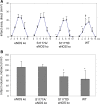Endothelial nitric oxide synthase transgenic models of endothelial dysfunction
- PMID: 20697735
- PMCID: PMC2975487
- DOI: 10.1007/s00424-010-0867-4
Endothelial nitric oxide synthase transgenic models of endothelial dysfunction
Abstract
Endothelial production of nitric oxide is critical to the regulation of vascular responses, including vascular tone and regional blood flow, leukocyte-endothelial interactions, platelet adhesion and aggregation, and vascular smooth muscle cell proliferation. A relative deficiency in the amount of bioavailable vascular NO results in endothelial dysfunction, with conditions that are conducive to the development of atherosclerosis: thrombosis, inflammation, neointimal proliferation, and vasoconstriction. This review focuses on mouse models of endothelial dysfunction caused by direct genetic modification of the endothelial nitric oxide synthase (eNOS) gene. We first describe the cardiovascular phenotypes of eNOS knockout mice, which are a model of total eNOS gene deficiency and thus the ultimate model of endothelial dysfunction. We then describe S1177A and S1177D eNOS mutant mice as mouse models with altered eNOS phosphorylation and therefore varying degrees of endothelial dysfunction. These include transgenic mice that carry the eNOS S1177A and S1177D transgenes, as well as knockin mice in which the endogenous eNOS gene has been mutated to carry the S1177A and S1177D mutations. Together, eNOS knockout mice and eNOS S1177 mutant mice are useful tools to study the effects of total genetic deficiency of eNOS as well as varying degrees of endothelial dysfunction caused by eNOS S1177 phosphorylation.
Figures





Similar articles
-
Requirement of phosphorylatable endothelial nitric oxide synthase at Ser-1177 for vasoinhibin-mediated inhibition of endothelial cell migration and proliferation in vitro.Endocrine. 2014 Mar;45(2):263-70. doi: 10.1007/s12020-013-9964-4. Epub 2013 May 3. Endocrine. 2014. PMID: 23640371
-
Functional regulation of vascular and platelet activity during thrombosis by nitric oxide and endothelial nitric oxide synthase.Thromb Haemost. 2010 Aug;104(2):342-9. doi: 10.1160/TH09-11-0764. Epub 2010 May 27. Thromb Haemost. 2010. PMID: 20508906
-
Lack of endothelial nitric oxide synthase promotes endothelin-induced hypertension: lessons from endothelin-1 transgenic/endothelial nitric oxide synthase knockout mice.J Am Soc Nephrol. 2007 Mar;18(3):730-40. doi: 10.1681/ASN.2006050541. Epub 2007 Feb 7. J Am Soc Nephrol. 2007. PMID: 17287431
-
Neuronal and endothelial nitric oxide synthase gene knockout mice.Braz J Med Biol Res. 1999 Nov;32(11):1353-9. doi: 10.1590/s0100-879x1999001100005. Braz J Med Biol Res. 1999. PMID: 10559836 Review.
-
Alterations in endothelial nitric oxide synthase activity and their relevance to blood pressure.Biochem Pharmacol. 2022 Nov;205:115256. doi: 10.1016/j.bcp.2022.115256. Epub 2022 Sep 19. Biochem Pharmacol. 2022. PMID: 36185001 Review.
Cited by
-
Endothelial nitric oxide synthase (eNOS) S1176 phosphorylation status governs atherosclerotic lesion formation.Front Cardiovasc Med. 2023 Nov 14;10:1279868. doi: 10.3389/fcvm.2023.1279868. eCollection 2023. Front Cardiovasc Med. 2023. PMID: 38034389 Free PMC article.
-
Chemical Atherogenesis: Role of Endogenous and Exogenous Poisons in Disease Development.Toxics. 2014;2(1):17-34. doi: 10.3390/toxics2010017. Toxics. 2014. PMID: 25705646 Free PMC article.
-
Loss of Endothelial Nitric Oxide Synthase Promotes p25 Generation and Tau Phosphorylation in a Murine Model of Alzheimer's Disease.Circ Res. 2016 Oct 28;119(10):1128-1134. doi: 10.1161/CIRCRESAHA.116.309686. Epub 2016 Sep 6. Circ Res. 2016. PMID: 27601478 Free PMC article.
-
Acute Effect of Low-Dose Space Radiation on Mouse Retina and Retinal Endothelial Cells.Radiat Res. 2018 Jul;190(1):45-52. doi: 10.1667/RR14977.1. Epub 2018 May 9. Radiat Res. 2018. PMID: 29741442 Free PMC article.
-
Role of endothelial nitric oxide synthase for early brain injury after subarachnoid hemorrhage in mice.J Cereb Blood Flow Metab. 2021 Jul;41(7):1669-1681. doi: 10.1177/0271678X20973787. Epub 2020 Nov 30. J Cereb Blood Flow Metab. 2021. PMID: 33256507 Free PMC article.
References
-
- Gimbrone MA., Jr Endothelial dysfunction and atherosclerosis. J Card Surg. 1989;4:180–183. - PubMed
-
- Gimbrone MA., Jr Vascular endothelium: an integrator of pathophysiologic stimuli in atherosclerosis. Am J Cardiol. 1995;75:67B–70B. - PubMed
-
- Gimbrone MA, Jr, Topper JN, Nagel T, Anderson KR, Garcia-Cardena G. Endothelial dysfunction, hemodynamic forces, and atherogenesis. Ann NYAcad Sci. 2000;902:230–239. discussion 239–40. - PubMed
-
- Ross R. Atherosclerosis is an inflammatory disease. Am Heart J. 1999;138:S419–S420. - PubMed
-
- Feron O, Belhassen L, Kobzik L, Smith TW, Kelly RA, Michel T. Endothelial nitric oxide synthase targeting to caveolae. Specific interactions with caveolin isoforms in cardiac myocytes and endothelial cells. J Biol Chem. 1996;271:22810–22814. - PubMed
Publication types
MeSH terms
Substances
Grants and funding
LinkOut - more resources
Full Text Sources
Other Literature Sources

